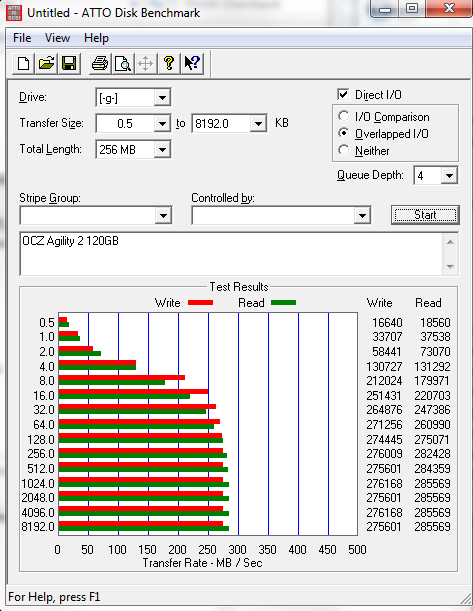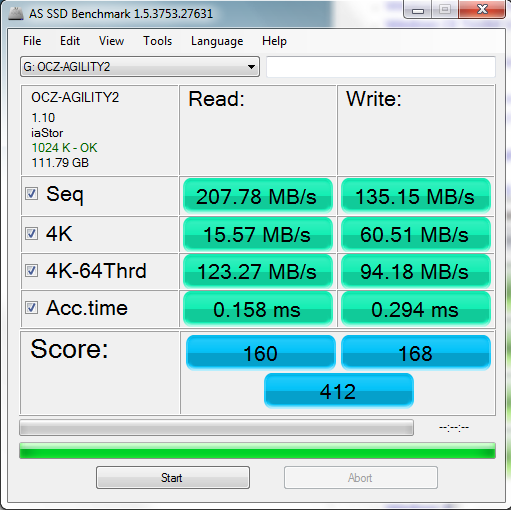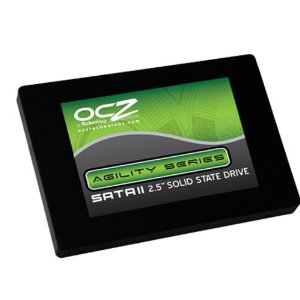OCZ’s Agility 2 120GB is a new generation of drive based on the SandForce SF-1200 controller. Unlike the OCZ Vertex LE and OCZ Vertex 2 drives, the Agility 2’s SandForce controller has an IOP limit artificially limited in firmware. With that being said, it is also cheaper than the Vertex 2 120GB and is still a very fast SSD, especially with compressible loads.
The short story of the SandForce controller is that it uses an internal encryption/ compression algorithm to write data to NAND faster than other drives. The SandForce based Agility 2 120GB is therefore fairly fast with compressed workloads (i.e. pictures, music files, zip files, ISOs, and etc) and much faster with compressible workloads such as office documents. Another major storyline is that SandForce is a fairly new player and the controllers are of unknown reliability. Finally, originally SandForce reserved much more space on drives in this capacity range for use in wear leveling, cache and etc. OCZ Agility 2 and Vertex 2 SandForce drives were originally 100GB but after being criticized for mediocre cost per GB and with little performance penalty moving from 28GB reserved (old drives were 100GB usable 28GB reserved) to 8GB reserved (new drives are 120GB usable 8GB reserved), the choice to enable the extra capacity was clear.
One can search for more detail, but that is the one paragraph summary of hundreds of 10-15 page reviews.
Test Configuration
I noticed that I have done a poor job listing the test system in articles from the first quarter of 2010 and earlier. As a result, here is test configuration:
- CPU: Intel Core i7 920
- Motherboard: Gigabyte X58-Extreme
- Memory: 12GB of Corsair Dominator GT 1600 C7 DDR3
- Case: CoolerMaster Cosmos S
- Drives (OS): 2x OCZ Vertex 120GB in RAID 0
- SSD: OCZ Agility 2 120GB
- Controller: Intel ICH10R with Intel Rapid Storage Technology (RST) 9.6.0.1014
- NIC (additional): Intel Pro/1000 PT Quad
- Host OS: Microsoft Windows 7 Ultimate 64-bit
This system is not the fastest around, however it is plenty to ensure that other hardware is not slowing down SSDs. I will note that the numbers I find in my testing may not be indicative of what one may see on an AMD or NVIDIA chipset.
OCZ Agility 2 120GB Benchmarks
On to the benchmarks! I am using my revised standard benchmark suite to make it easy to compare to other SSD reviews I have posted.
CrystalDiskMark
I have used CrystalDiskMark (and an older one at that at version 2.2) for quite a while now, and so I am providing these results as a point of reference.

This is one reason SandForce SF-1200 drives like the OCZ Agility 2 have received both praise and complaints. OCZ’s Agility 2 120GB provides solid CrystalDiskMark numbers, however there is one blaring issue. The sequential read speeds are over 500MB/s for the OCZ Agility 2 120GB SSD in CrystalDiskMark, yet the SATA II max bandwidth is 3.0gbps or 293MB/s. This is a good example of how SandForce numbers provide some interesting benchmark results.
ATTO Benchmark
ATTO has been one of my longstanding favorite benchmarks as it usually gives a different view of drive performance than a lot of the other quick benchmarks available.

The ATTO benchmark shows one simple trend without anomalies like CrystalDiskMark. The OCZ Agility 2 120GB SSD is fast. The 285MB/s read speed is basically at the limit of SATA II and the 275MB/s write speed is very good also. One will also notice that the small file size speed is also strong.
There have been some reports of ATTO Benchmark results degrading significantly over time on SandForce based drives and users needing to RMA drives in response. I have been using the OCZ Agility 2 120GB SSD for approximately ten days writing 80GB/ day and my ATTO benchmark scores have been holding constant +/- 3MB/s which is a fairly normal variation.
AS ASSD Benchmark
The AS ASSD Benchmark was developed specifically to test SSDs. This is a new benchmark to my suite that I started to use in the Intel X25-V 40GB RAID 0 benchmarks.

Sequential reads and writes are good, but much lower than ATTO and CrystalDiskMark. This is a major reason I added another benchmark to the suite.
4K writes are very good, in fact better than the Intel X25-V 40GB drives in Raid 0. The 4K-64Thrd numbers are also very strong. I was fairly surprised at the write access times, but they are still twenty times faster than most spindle disks.
Conclusion
Even with the performance anomalies, the SandForce drive is fast in real world usage. Then again, just like I experienced with my first SandForce drive, the OCZ Vertex LE 100GB, the performance differential is not enough to make a current Indilinx or Intel drive user astonished by real world performance gains. I will note that with the price being competitive with the Indilinx 120GB drives, one may look to the OCZ Agility 2 or Vertex 2 120GB as being an incremental upgrade over older technology. Then again, Indilinx has been field tested by many more users for well over a year so reliability is well known at this point while SandForce is a relative newcomer. I do think OCZ should be a bit more forthcoming in marketing efforts as they clearly advertise the OCZ Agility 2 120GB’s 285MB/s read and 275MB/s write speeds, yet other benchmarks show a different picture. Overall, I have been impressed with the OCZ Agility 2 120GB, and now that much of the reserved space has been freed up for use, the cost per GB is in-line with previous generation SSD technology.





I can’t decide between this and an Intel X25-M 80GB. A lot of people say SandForce is fast. A lot say SandForce is slow real world. Good to see another data point that SandForce drives are not ultra slow.
same as I saw with my ocz vertex le 50gb, great atto but not as good since only 50gb, good all around tho
I have four of these in my own office 2 in raid running my Vmware ESXI Linux vm test box, one in my desktop making it wicked fast, and the last in my laptop running Ubuntu 10 at ludicrous speed. (space balls the movie anyone?). I also have two more sets in production servers running MySQL and vm servers out in the wild. I am very happy with both the speed and reliability in production systems to date. The oldest is only about 4 months or so old but it gets hammered daily so the true test is time, I have backups of each to slip in and re image if the need comes about. The VM guests are faster then the live boxes they were on with raid 10 on 4 SAS drives. Get em while there hot.